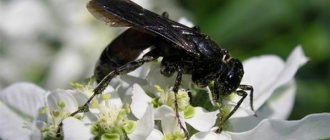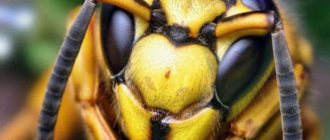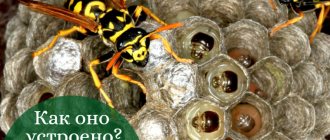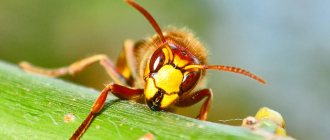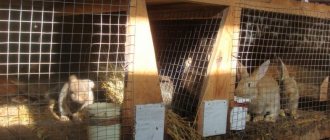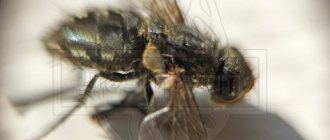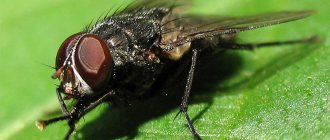Description of the life functions of hornets. When do they build a new nest? Do they hibernate? What is a hive made of? How to destroy a hornet cocoon, eliminating the risk of attack by dangerous insects. Providing first aid for a bite.
Hornets are large representatives of the wasp family. Their appearance causes fear and anxiety among many. This is not at all surprising, since this type of insect is a predator that amazes with its size. Ordinary individuals reach a length of up to 3.5 centimeters, but some species can reach 6 centimeters. It is also worth noting that an insect bite is quite dangerous for people, since they release twice as much poison as when attacked by a bee. It should be noted that the stinger does not have serrations, which allows them to attack the victim several times.
Although such characteristics are scary, we must remember that these are beneficial insects for nature. The adult feeds on vegetation - berries, fruits, nectar, but their larvae feed on caterpillars, flies, mosquitoes, beetles, spiders and other small parasites, which the adults catch for them. In one day, one hornet family can catch up to 0.5 kilograms of pests, which is important for the circulation of the ecosystem. Below we will look at the features of life, the appearance of the nest, how to deal with them and ensure safety.
Why do they attack?
These representatives of the wasp family are not as aggressive as wasps and bees; they will not attack without a good reason, and will try to stay as far away from humans as possible. Most often, the reason for attacks is threats to their home or the individual itself.
It is important to understand that unjustified destruction of beehives is a bad idea, since many of the species are rare and are at the stage of extinction, some of them are listed in the Red Book. It is worth fighting them when there is a risk of presenting a danger to human health.
Hornet: as a source of danger
In fact, hornets (Vespa) are loyal if they are not disturbed and the nest with the queen, larvae and worker wasps is not threatened. But still, the proximity to poisonous Hymenoptera is not so pleasant. You cannot put up with them even when there are children living in the house or dacha who are capable of provoking the hornets to aggression with their behavior. Even unintentional contact with an insect (accidentally crushed under a shirt, stepped on, sat down, etc.) causes a response. A strong body can cope with the effects of the injected poison, but allergy sufferers have a very bad time. Beekeepers don't like hornets either. They not only destroy the hives, but also destroy the bee family.
What does the nest look like, photo
Hornets are real architects; their hive is distinguished by its thoughtfulness, precise shapes and practicality. The shape of the convergence with a ball or cones. On average, the size of their home is from 30 to 50 centimeters in width and from 50 to 70 centimeters in length. If the habitat has optimal conditions for life activity, you can notice a much larger hive - more than a meter. The weight of an empty nest in rare cases can exceed 1 kilogram.
The structure itself is similar to a multi-storey building, which has a large number of rooms and a couple of entrances. The rooms here play the role of honeycombs, and the entrances - compartments, which are formed around an axis, and their separation is carried out by means of a thin partition. In a perpendicular arrangement there are floors in the form of tiers - along them the uterus moves. They are attached to each other using several legs.
Most often, one dwelling contains 3-4 compartments and 7-10 tiers; the design itself is characterized by neatness, airiness, and a spectacular appearance.
The most common types of wasps and hornets
Wasps and hornets belong to the same family - True wasps, folded-winged wasps (lat. Vespidae) . They feed on other insects (mosquitoes, flies and bees), fruits and tree sap. They can cause great harm in cultivation, especially in the garden of stone fruit trees. They are also a great threat to bees, because in addition to the massive destruction of these beneficial insects, their honey is stolen.
There are several species of these insects in our area. Many of them live near areas where people live. The most common of them:
- Common wasp (lat. Vespula vulgaris) - body length is 10-20 mm, builds nests in the ground;
- The German wasp (lat. Vespula germanica) is smaller - its body length is 10-12 mm, builds a nest on the ground, in the walls and on the roof;
- Forest wasp (lat. Dolichovespula sylvestris) - its body length is 14-18 mm, inhabits tree hollows, balconies and attics;
- Common hornet (European) (lat. Vespa crabro), often the name is shortened simply to “hornet” - the body length is 20-25 mm, nests in hollows, streets, sheds, under the roofs of verandas and sheds.
You can increasingly hear about the invasion of hornets from Asia. Although the Asian hornet is not significantly different from its European counterpart, Vespa Mandarinia is a true spikelet - its body length reaches 60mm. One such individual can kill even several dozen bees within a minute.
Finding a nest
In general, the hornet is a beneficial insect that does not harm humans unless it poses a danger to them. If you come across a hive in a natural area, outside the area where people live, you should not try to destroy it or destroy it, since in such cases the insect is part of the natural environment where they play an important role.
If a hornet family has settled near people, you need to be especially careful, since such proximity is dangerous, especially when setting up a hive in a frequently visited area.
They provide deadly proximity to bees, since they are capable of attacking an apiary, destroying adult representatives, larvae, and also eating honey. In the case of regular appearance of hornets in summer cottages and gardens, even with a small group of predators, you should think about starting to search for a nest. Pictures of the appearance can be seen below.
We advise you to start searching for a hive at the initial stage of its formation. The function of the base of the nest is performed by the queen, who lays the first tier and immediately lays eggs inside the honeycomb. During such a period, it is possible to destroy it without problems and much difficulty. But after several weeks, there is a rapid increase in the number of young members of the family, which will become more difficult to get rid of.
Those who sting choose a quiet, secluded place that is maximally protected from bad weather conditions - this can be a hollow inside a tree, a hole in the soil, an abandoned building, a barn, or an attic.
It is best to organize the search in the following sequence:
- Conducting preparations. Encountering such giant stinging wasps is a dangerous undertaking, so proper preparation for such a process is important - make sure you have anti-allergy medications and closed clothing made of thick fabric (you can buy a special protective suit).
- Beginning of the inspection of the premises. Carefully examine the territory of attics, basements, sheds, and outbuildings. They often build a hive in a window frame, under the floor, even in a wall - such locations are quite dangerous and the process of dealing with them will take a long period.
- Conducting an inspection of the entire territory. You need to explore the garden, trees, logs, stumps. It is also worth taking a closer look at the presence of burrows in the soil, especially under trees.
- Listen. If the inspection does not give the desired result, try to hear them - these insects make quite a lot of noise, especially during the construction of the hive.
- Tag the pest is an interesting technique that can be used when the search does not bring results. To do this, catch the hornet and mark it with a bright thread or tape, then release it and track where it goes.
Interesting fact.
Many people believe that these insects sleep at night, but this is not the case, their activity decreases, but they are still ready and will zealously defend their home in case of danger.
If you find a nest, you need to determine how dangerous its inhabitants will be for humans. It depends on the location. If you have a hive in a corner where people and insects do not intersect, leave them in peace and do not disturb their house.
If the housing is located in a frequently visited area, then destruction is required, which is very difficult, since the hornet family is always active and displays aggression for protection. Look at the photo to see what a cocoon looks like.
Among the most effective methods that suggest the ability to destroy a hive are:
- Treatment with insecticides;
- Drowning;
- Burning;
- Pouring boiling water.
The presented options are tough and risky, so they should be used only as a last resort.
How to find a hornet's home?
It should be remembered:
If you begin to notice unnaturally large wasps, up to 1.8 - 2.5 cm in size, in your summer cottage or garden plot, as well as in the apiary, it means that there is a hornets nest somewhere nearby.
If you observe them in large numbers, then the home of these insects is very close. The best option to find him would be to follow the uninvited guest, because, having caught prey, he will definitely fly to his nest. But this may not happen right away, and during the flight of the hornet you can lose sight of it.
To make your search easier, you need to resort to tricks, taking special care. To do this you need:
- shoot down a hornet in mid-flight with a tennis or badminton racket;
- wearing thick gloves, take the insect and tie a thick light thread to its body, clearly visible against the background of greenery and other vegetation;
- throw the hornet to the ground, quickly moving away to a safe distance;
- follow the flying insect, which will now immediately fly to the nest.
Having discovered a hornet's home, there is no need to rush to get rid of it. Careful consideration should be given to how and when best to do this. Until then, it is undesirable to approach the nest so as not to cause aggression from its inhabitants. After all, these creatures carefully guard their home and rush to its defense with rage.
How many hornets live in a nest
This factor depends on how comfortable their habitat is for them, as well as on the influence of the external environment - weather conditions and the availability of food are important. The structure accommodates one family, the number of which can number a couple of hundred adults, most often their number ranges from 400 to 600 individuals.
The presence of optimal conditions, a calm, quiet and warm place where there is a large amount of available food turns the family into a strong one and capable of breeding high-quality offspring in impressive quantities. Such cases are characterized by the achievement of a gigantic size of the dwelling - its diameter can reach a meter, and the family can consist of one to two thousand representatives.
A little about hornets
Hornets are very large wasps, up to 5.5 cm long. They live in colonies of up to 400 individuals. They build horizontally located nests, which are honeycombs in several rows of five hundred cells each.
Giant wasps make their homes in warm places that are protected from winds and rain. They often prefer proximity to humans, as they like to eat the remains of human food. They also eat other smaller insects, rotting fruits, and drink plant juice.
Construction process
The way the hive construction process is carried out surprises everyone - the insects put in a lot of work, discipline and self-organization. They try to make their own home as comfortable and durable as possible, capable of protecting them from hot and cold weather conditions.
The choice of material that serves as the basis of the nest is also interesting - they use wood and bark. They especially fell in love with birch, which is why their buildings have a lighter shade than those of wasps or bees. They carefully chew pieces of wood, moistening them with saliva - the resulting material allows them to sculpt honeycombs, walls, partitions and shells.
The choice of a place for construction is made by the queen, who begins the construction of the future house. Initially, she begins to sculpt the first ball of cells, where she lays eggs. After about a week, the eggs hatch into larvae, which after 14 days turn into pupae. After another two weeks, the nests are replenished with young workers, continuing the construction of housing.
The number of insects that will develop in the season also depends on the level of productivity of the new generation. After the worker hornets fly out, eggs of future females and males are laid. Since emergence begins at the sexually mature stage, swarming occurs immediately after this.
Hornets habitat
Hornets inhabit the northern part of our planet. Their varieties are found in different climatic zones. Insects feel comfortable both in Europe and in hot Asian countries.
Hornet nests can be found in the forest, in bushes. They are often located in close proximity to people: at various agricultural enterprises, country and outbuildings, and street toilets.
When insects fly out of the hive
At the end of autumn, the home begins to gradually empty. If you want to figure out when representatives of the wasp family leave the hive, you need to clarify certain nuances.
The death of males begins almost immediately after swarming. With the onset of cold weather, the death of workers and the queen begins. At this time, a search is carried out for a suitable secluded and warm place for wintering by fertilized females.
With the beginning of the autumn period, the female begins to produce a special substance, which in winter frosts is a kind of antifreeze that prevents their body from freezing during the period of suspended animation. Trees, hollows, and outbuildings serve as temporary housing. Some of the individuals may overwinter inside the old hive.
Only a small percentage of insects can survive the cold calmly. From the moment of the first warm days, females leave their temporary shelter and look for a suitable place to start establishing a new cocoon. Interestingly, hornets do not settle in old nests and always start building a new house.
Taking into account behavioral characteristics and differences in the life cycle, the optimal period for removing hives is the end of autumn, winter. This time is characterized by the absence of huge wasps in them, so there is no risk of being attacked by them. The nests are easily removed if you file down the base, then you need to burn it.
How to deal with dangerous insects?
Given the behavior and life cycle of hornets, it is best to destroy and remove hornet hives in late fall and winter. At this time, the nest is empty, there is no risk of insect attack. The nest can be easily removed by sawing off the base and burned.
What to do if bitten by a hornet? More details
Methods of destruction
The presented insects use nests seasonally (only in spring, summer, autumn). After this, they leave them, most of them die, and the fertilized females try to hide in secluded places (hollow, under the bark of wood). With the onset of cold weather, they enter a process of diapause, which continues into the spring season.
The process of removing a house along with its inhabitants is very difficult, since they diligently guard the place of residence and, if necessary, will attack people, causing them pain and unpredictable consequences after bites.
Because of this, you need to consider and take safety measures:
- The use of clothing made of dense material should have long sleeves, and the cuffs should fit snugly to the skin;
- Covering your head with a thick hat; it is best to choose protective helmets with mesh;
- Feet must be protected with boots, hands with gloves;
- Wear safety glasses/mask on your face;
- The ideal option in such cases is a special beekeeper suit;
- Make sure to prepare a disinfectant and anti-allergenic agent in case of a bite;
- Think over an escape plan in advance if the swarm follows you - a pond or an enclosed space is suitable here;
- If children or people suffering from allergic reactions live on the premises, they should be temporarily relocated to a safe place.
Benefits and harms
- In the course of their life, adult individuals actively hunt for other insects, including agricultural pests. This can be attributed to the benefits of hornets. It is incommensurably small in comparison with the harm they cause to humans. People living in areas infested with hornets are in constant danger.
- Hornets do not like other people's neighborhood and react aggressively to it. Their bites are very deep and painful and take at least a week to heal. Hornets often attack people in a swarm. If the risk of death from a single bite is extremely small, then the consequences of an attack on a person by a swarm of hornets can be fatal for him. Insect bites are especially dangerous for the elderly, children and allergy sufferers. Hornets cause damage to plantings by eating the pulp of ripe fruits and berries.
Choosing a drug to combat stings
Now there are a number of methods that make it possible to destroy the nest and its inhabitants.
But it is best to do this at night or at dusk:
- Drown the hive in a bucket of water/kerosene solution - this option does not necessarily require removing the cocoon. If the dwelling is located on top, the bucket should be raised to it, and then a ladder should be placed at the bottom. The hive should be in the liquid for several hours, preferably all day. After waiting the necessary time, you can clean the softened house.
- It is not so easy to ensure the removal of the nest if you treat it with an insecticidal aerosol, which is intended to destroy pests - popular products are such as Executioner, Get, Karbofos, Lambda Zone. Buy 2-3 bottles at once. Spray the entire internal cavity through the inlet holes, then move away as far as possible and do not touch the cocoon for several days. This period will be enough to destroy those individuals that were inside and those that arrived after treatment. At the end of the procedure, burn their house.
- Treating the nest with fire extinguisher foam - try to wet each cell - in such cases, each resident will freeze, after which you can tear off the hive at the base and destroy it.
- Nests that hang in the wind of a tree can be burned by first dousing it with kerosene or gasoline, but here you need to be especially careful to avoid the risk of a fire.
- When settling hornets inside a hollow that has a narrow entrance, pour one of the strong chemicals into it, and then quickly seal the gap.
- Reliable extermination of the nest and colony is possible using a large plastic bag, which is pre-treated with an insecticidal preparation. It is used to cover or wrap a cocoon - an excellent option when the nest is located inside a house/apartment.
- Blocking the entrances to the socket using polyurethane foam.
- When placing the family inside a hole underground, you can use boiling water and make a fire, digging up the entrance holes a little.
- Underground housing can be filled with kerosene and then set on fire.
Each of the above methods must be used in the evening or at night - with minimal activity of predators. Despite the fact that many people believe that hornets sleep at night, this is not the case - they can rest or do other things. Use a flashlight during this procedure with caution, since the insect will immediately react to changes in lighting.
What does a hornet eat?
The diet of hornets is dominated by foods rich in sugars. They feed on ripe berries, fruits, and even wood. They can attack other insects: bees, grasshoppers or wasps. They kill prey with their venom and then tear it apart with their powerful jaws.
Scientists note that hornets are especially dangerous to honey bees. Hornets often destroy large colonies of such bees because they are attracted to the aroma of honey.
In addition, insects can also feed on various food waste (dairy products, fish or meat).
Traps
Various types of insect traps have become very popular; stores offer a wide range of similar products.
But you can make them yourself without much difficulty:
- Take a plastic bottle with a volume of at least 1.5 liters and cut off the top neck.
- Pour aromatic bait into the prepared container, which will attract the wasp family - jam, honey, beer are suitable for this - it is best to mix these ingredients.
- Insert the top of the bottle into the main part, so that the neck faces the bottom. But don't forget to remove the cover.
- As an additional measure, lubricate the neck with oil.
Hornets will fly into such a ready-made trap, after which they will not be able to get out. And if some of the individuals are able to get to the neck, they will still not be able to get out, since it will have a slippery coating.
Traps are prohibited from being used in only one case - when a bee apiary is located near the site.
Ensuring security measures
When determining a method of dealing with a hornet's nest, you first need to take care of your own protection from pests. The most suitable option in this case is a beekeeper’s mask, closed clothing, and gloves made of thick fabric.
If the wasp family's refuge has a complex configuration, rapid processing is not possible. If you see an insect, then immediately leave the place, but do not make sudden movements.
What to do if bitten
First of all, you need to have an antiseptic, an antihistamine, and a compress. First, you should drink a drug that neutralizes the effect of histamines in the body’s blood (comes with the poison).
Suprastin is best suited - this remedy makes it possible to relieve swelling and reduce the intensity of allergic symptoms. The affected area on the skin should be treated with alcohol and hydrogen peroxide.
After such manipulations have been performed, apply a cold compress to the affected area of the victim - this will reduce the rate of spread of the poison through the blood. With proper preparation for the process of destroying a hornet's nest (thick, covered clothing, gloves, a beekeeper's mask with a net), the likelihood of being attacked by stinging insects is reduced to a minimum.
Providing first aid for a bite
If a person does suffer from a hornet bite, it is necessary to take action as quickly as possible in order to prevent possible complications of the victim’s condition.
First aid must be provided in the following order:
- Suck out the poison from the affected area on the skin - this procedure must be carried out immediately, since effectiveness is possible only within a short time from the moment of attack until the poison spreads through the blood. Of course, this will not prevent all consequences and will not eliminate the risk of allergies, but it will significantly reduce the intensity.
- Apply ice or something cold to the bitten area - this action will reduce pain and prevent swelling from growing.
- Do not touch the affected area, as any rubbing or scratching of the wound will help stimulate blood circulation, which maximizes the rate of spread of the poison throughout the body, and there is also a risk of infection, which will only worsen the victim’s condition. Do not try to find the sting, since the hornet, due to its smooth surface, will not leave it in the wound (unlike a bee).
- Disinfect the affected area of the skin using any available method - you can use hydrogen peroxide, medical alcohol or other disinfectants. The bite should be treated with the utmost care, excluding any pressure.
- Apply wet sugar to the bite area, having previously wrapped it with a bandage or towel - this action makes it possible to draw out a certain amount of poisonous components that have not yet had time to disperse throughout the human body. Remove the bandage after 10 minutes - this period is enough to draw out the possible amount of poison.
- Take a swab, pre-moisten it with citric acid/vinegar and apply it to the affected area - the procedure will reduce the inflammatory process and reduce the intensity of the allergic reaction. This is done due to the fact that toxic substances contain alkali, and acid can destroy the structure.
- If there are pronounced consequences of the attack, severe discomfort and no improvement in the condition for several days, this is a serious reason to seek urgent help from a specialist to receive professional medical care.
Prevention of hornets
To exclude the possibility of hornets settling in garden plots or apiaries, gardeners begin to closely monitor them in the spring when females appear and begin searching for a favorable place to create a colony after hibernation.
Having found a suitable place, the female begins to sculpt a cocoon to breed offspring in it and organize a colony. At first, in appearance they resemble a walnut - during this period it is easily torn off with a shovel or other tool, then it must be crushed and burned.
In addition, experts advise creating special traps in the spring to catch queens - this can be done by placing a bucket of water diluted with something sweet or sour on the site, and also adding soap. The insect flies to the scent, and then drowns, as it cannot choose from the liquid.
The situation is similar with a trap that is made on the base of a plastic bottle - you need to cut off the neck and place it in the form of a “funnel”. Honey and beer are poured inside, which attracts insects. The pests can no longer get out.
The presented methods make it possible to exclude the spring settlement of colonies in plots or apiaries. With the onset of summer, the large queen sets up her home, so the risk that they will arrive decreases.
Please note that killing a hornet is a bad idea, since by crushing their body, it will release a substance with an odorous pheromone, signaling the presence of danger to its fellows, thereby they fly to the rescue. As a result, a person may face a massive attack by an entire family of stingers.
